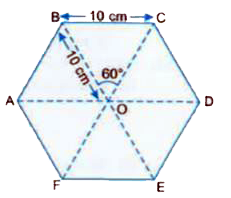The centre of a regular hexagon is at the point z=i. If one of its vertices is at 2+I, then the adjacent vertices of 2+I are at the points Solution in Tamil
A. 1±2i
B. i+1±√3
C. 2+i(1±√3)
D. 1+i(1±√3)
The correct Answer is:D
Step by step video, text & image solution for The centre of a regular hexagon is at the point z=i. If one of its vertices is at 2+I, then the adjacent vertices of 2+I are at the points by Maths experts to help you in doubts & scoring excellent marks in Class 12 exams.
Updated on:21/07/2023Topper's Solved these Questions
- COMPLEX NUMBERS AND QUADRATIC EQUATIONSBOOK - NEW JOYTHI PUBLICATIONCHAPTER - COMPLEX NUMBERS AND QUADRATIC EQUATIONSEXERCISE - EXERCISE
50 Videos
- BINOMIAL THEOREMBOOK - NEW JOYTHI PUBLICATIONCHAPTER - BINOMIAL THEOREMEXERCISE - QUESTIONS FROM COMPETITIVE EXAMS
51 Videos
- CONIC SECTIONS BOOK - NEW JOYTHI PUBLICATIONCHAPTER - CONIC SECTIONS EXERCISE - EXERCISE - HYPERBOLA
9 Videos
Similar Questions
formula for Modulus of a complex number is
View SolutionIf T, denotes the rth term in the expansion of [x+1x]23, then
View SolutionThe vertices of the hyperbola 9x2−16y2=144
View SolutionThe centre of a regular hexagon is i.One vertex is 2+i and z is an adjacent vertex. Then z is equal to
View SolutionSix point charges are arrange at the vertices of a regular hexagon of side length a (shown in figure). Find the magnitude of electric field at the centre of regular hexagon.
View SolutionA regular hexagon of side 10 cm has a charge 5μC each of its vertices, Calaculate the potential at the centre of the hexagon.
View SolutionIf centre of a regular hexagon is at origin and one of the vertices on Argand diagram is 1+2i, where i=√−1, then its perimeter is
View SolutionFour identical point charges, each of charge q, are placed on the vertices of a regular hexagon of side a such that the net electric field at centre of hexagon is zero. If one of the charge is now removed, then the electric field at centre of hexagon is k- 4.60
View SolutionA regular hexagon of side 10 cm has a charge 5μC at each of its vertices. Calculate the potential at the centre of the hexagon.
View SolutionA regular hexagon is drawn circumscribing the circle with centre (1,1√3) and radius 2. (3,√3) is one vertex and other vertices are (xi,yi),i=1,2,3,4,5. Then, 5∑i=1(xi+yi) is
View SolutionA regular hexagon of side 10 cm has a charge 5μC at each of its vertices. Calculate the potential at the centre of the hexagon.
View SolutionA regular hexagon of side 10 cm has a charge 5μC at each of its vertices. Calculate the potential at the centre of the hexagon.

View SolutionSix point charges are arrange at the vertices of a regular hexagon of side length a (shown in figure). Find the magnitude of electric field at the centre of regular hexagon.
View SolutionIf two consecutive vertices of a regular hexagon be z and ¯z , find the other vertices if the centre is z = 0.
View SolutionA regular hexagon of side 10 cm has a charge 5μC at each of its vertices. Calculate the potential at the centre of the hexagon.
View Solution
